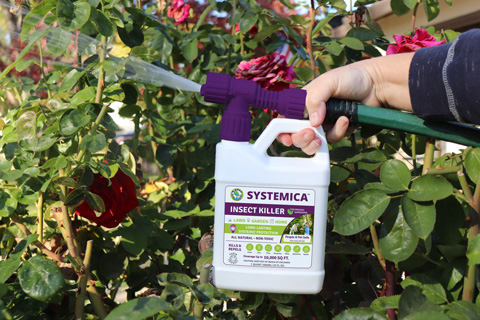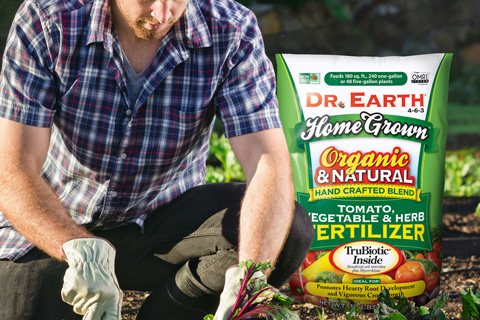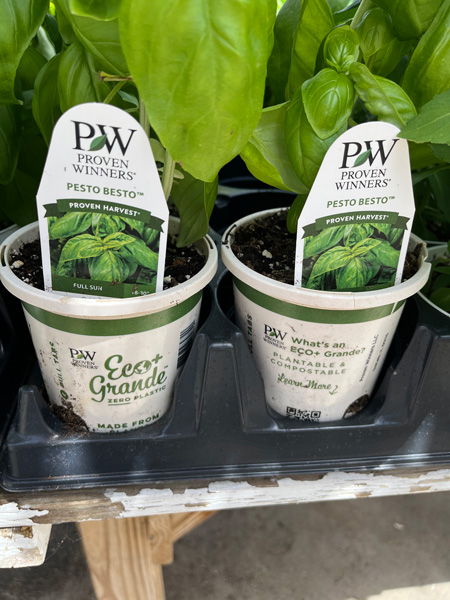12/1/2022
The Long Game
Jennifer Polanz

The one constant among most organic and natural products is education.
We preach education a lot in these pages because it’s often the biggest barrier to purchase. And that’s never more true than with organic and all-natural products, where customers may not be used to the speed at which they work or their effects over time.
Pictured: The all-natural Systemica systemic pest control comes in a hose-end sprayer for retail and a powder form will be coming soon from Sierra Natural Science.
But there’s no doubt organic and natural products have gone from niche to mainstream, particularly among younger audiences. That’s why it’s important to make the effort to work on the education part to help customers become more successful with them.
“The most important thing is the consumers,” says Milo Shammas, founder of Dr. Earth organic products, who’s passionate about the topic. “Consumers are demanding natural and organic products; that’s just the gravitational market shift. If a retailer is not selling organic products, they are missing out on the majority of gardeners.
“Younger demographics shy away from anything that isn’t organic or natural products. You have to have the supply that consumers demand.”
The Learning Curve
There are definite differences in how organic and natural products work versus synthetic, and that can cause issues if the customer isn’t using it properly.
“Basically, the rule of thumb is with these products it takes more. It just takes more, either on the manufacture side—so we try to make the concentrate as strong as possible, but there’s a limit to the chemistry because we’re fighting with nature—and on the consumer side,” says Chad Dempsey of Sierra Natural Science, which is introducing a new all-natural systemic insecticide to the home garden market called Systemica. “Typically, when you’re fighting with nature it takes more applications.”
 Pictured: The Dr. Earth brand includes a wide variety of fertilizers (like this Home Grown Tomato, Vegetable & Herb Fertilizer), soils, pest and disease controls, and mulches.
Pictured: The Dr. Earth brand includes a wide variety of fertilizers (like this Home Grown Tomato, Vegetable & Herb Fertilizer), soils, pest and disease controls, and mulches.
Communicating to customers that they need to apply more of the product more often can help them better understand the differences. And it’s up to the manufacturers, Chad adds, to communicate that the products are pet and human friendly via messaging and labeling.
“If you can get past that point and get into a new rhythm of using these products you probably will never use the hard chemicals again,” he says. “You have to be a little more patient. The insects don’t die right away. Most of the time they don’t exactly die right on the spot like if you sprayed Raid on an ant.”
A Broader Message
Milo has a broader message about his products, too, which range from organic fertilizers and soils to pest and disease control and mulches. Not only are the products OMRI-certified organic, but the company makes sure the ingredients are as pure as possible and the company as a whole is carbon
negative.
The products are made on a 160-acre farm in California and they convert food waste from supermarkets into the fertilizer they sell. Otherwise that food waste would end up in a landfill.
“I think that’s a big part of the purpose,” he says. “When you exist to solve a problem. It’s sold as certified organic fertilizer—it’s a beautiful closing of the loop and really solves the problem.”
For Milo, the message is two-fold: it’s creating awareness and educating customers about the product, and it’s about making it easy to find and buy. That’s why he advocates for all-organic or natural sections of products like you’d find at the grocery store. Rather than interspersing them with other products, he says creating a destination for all-natural and organic products can help the customer find what they want faster.
“If you can group like items together, what I’ve learned over the years is you’ve removed a major learning barrier and purchasing barrier,” he adds.
Other Added Benefits
In asking about margin on organic and natural products, the answers were they were slightly less or comparable to synthetic controls and fertilizers. Retailers can make sure they achieve their margin on these products by communicating benefits to the consumer and talking about how they can be slightly more expensive to make, since many are based on oils that require distillation.
“Knowledge has a price tag,” Milo says. “I truly believe that. Consumers who go to the independent garden center are willing to pay more because they walk away with the knowledge to succeed.”
Other benefits include ease of storage and handling, and disposal. For example, Systemica is EPA exempt, Chad says, so as long as the company follows labeling guidelines it doesn’t have to be registered. That means it also can be used and then either put in a recycling bin or thrown in the garbage. There’s no special disposal necessary. Milo’s products are the same, and for storage he simply says to make sure they’re covered in a dry location (planting mixes can be outside).
In the end, there’s been a definite shift in consumer sentiment, Milo says, toward organic and natural products. It’s up to the retailer to position the products and educate the customer, but the learning curve isn’t nearly as steep as it was when he started his company at 22 years old.
“Those entering the category today don’t have to do the hard work that we did and the garden center had to do,” he says. “These products are broadly accepted today versus 10, 20 years ago.”

Partnering For Eco-Success
I recently caught up with Danny Mishek, president of Vista Tek, the manufacturing partner behind Proven Winners’ new Eco+ Grande industrial compostable pot. The process has taken about five years from the beginning stages of research and design to testing, and then now offering it to growers.
It’s a fascinating arc of events for a third-generation plastics manufacturer from Stillwater, Minnesota.
“I asked myself, what can I do to be more sustainable, especially in manufacturing,” Danny says, noting that he was inspired by his children to find better ways to manufacture products like garden pots.
Pictured: The Eco+ Grande pots can be used in the drop-in trays, as seen here on the bench at Harvey’s Farm & Garden Center in Westborough, Massachusetts.
He cites all the usual problems for making an eco-friendly pot as the challenges his company had to face: the fact they had to run through automated machines, they had to withstand heat and humidity, as well as straight-on watering without breaking down. But they have to eventually break down, which also is a challenge to get them to do it fast enough. It has to look good at retail, as well—yet another challenge.
They settled on a base material of polyactic acid (PLA), which is made from plants like corn, switchgrass and sugar beets, and processed in a way that helps it act like a petroleum-based plastic. They added nutrients like agricultural byproducts in the pot to help break it down faster. The Eco+ Grande also has a plant-based label with soy ink, which all allows it to meet the ASTM D6400 standard for industrial composting. And there are tabs on the bottom to tear off to allow the roots through.
The end goal for the consumer? To be able to either plant the pot in the ground or a container without taking the plant out of it, or take the plant out of the pot and send the pot to industrial composting. A third option is to break the pot up and mix it in with the soil to provide more nutrients and allow it to break down naturally.
Danny says he’s been working with growers, too, receiving feedback to create better designs and continue to work on developing the pots. He’d like it to break down faster, and he’s continuing to work on that, as well as look at creating tags that are also eco-friendly. There are larger sizes coming, as they’re looking at a quart-size prototype potentially for 2024. And Proven Winners expects to make a big push with the product on social media and through influencers to get the word out.
For Danny’s part, he says his personal sense of pride is off the charts for what they’ve accomplished so far.
“It’s been fun to be a part of this. My kid’s friends are even proud of what their dad is doing,” he adds.
Interested in a sample of the Eco+ Grande pots? Visit www.provenwinners.com/product/proven-winners-ecogrande-sample-pack-10. GP